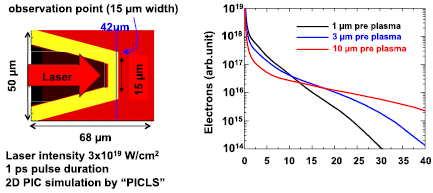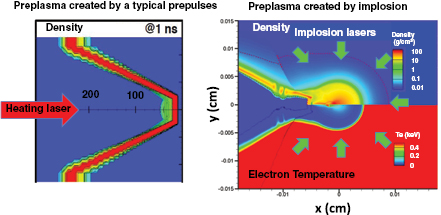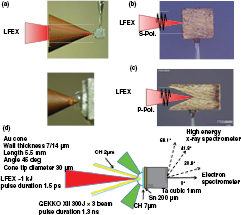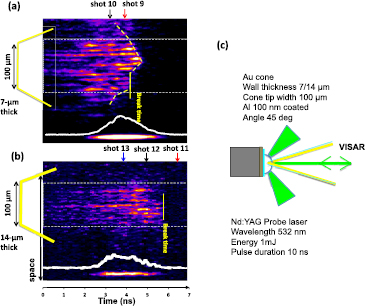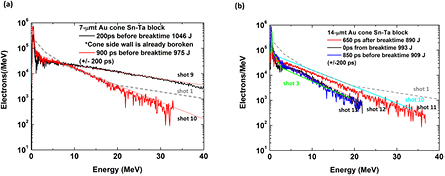Abstract
The study of fast electron spectrum optimization by suppression of preformed plasma in fast ignition targets is presented in this work. Integrated fast-electron spectra for electron energies below 3 MeV—the energy range responsible for core heating—are compared for different preformed plasma conditions. The pulse contrast (the ratio of peak-to-pedestal laser intensities) is compared for 108, 109 and 1011 conditions at constant laser energy (~500 J), pulse duration (2 ps), spot size (30% encircled energy on 50 µm diameter) and laser intensity (around 1 × 1019 W cm−2). The best electron spectrum optimization, consisting of maximized electron number for energies below 3 MeV was obtained with 14 µm thick cone targets. The energy coupling efficiency from heating laser to core plasma, assuming typical core plasma parameters, was estimated to be 2%, although 0.37% was obtained with previous conditions with poor pulse contrast and a 7 µm thick cone target.
Export citation and abstract BibTeX RIS
Corrections were made to this article on 03 May 2017. Author names were corrected.
1. Introduction
In the fast ignition inertial confinement fusion scheme, fusion fuel is compressed using implosion lasers of nano-second pulse duration. At peak compression time, the heating laser heats the compressed plasma core to the ignition temperature [1, 2]. The heating laser interacts at the tip of a cone shaped target attached to a fuel capsule; fast electrons are accelerated through the cone tip and heat up the core plasma. For the LFEX laser (laser for fast ignition realization experiment), which is the heating laser used at the Institute of Laser Engineering, Osaka University, the laser energy was limited to 10 kJ at maximum. Since 2 kJ of laser energy deposition is needed to heat the typical core plasma to 5 keV [3], 20% energy coupling efficiency from a heating laser to a core plasma is strongly required and represents one of the milestones yet to be reached in fast ignition science. The laser-to-electron energy conversion efficiency is limited to about 60% [4, 5], therefore requiring a 30% energy coupling efficiency from the fast electron beam to the core. There are several issues that must be improved in the fast ignitor core heating process, such as the electron energy spectrum, the electron divergence angle and the electron transport in the core plasmas [6]. Fujioka et al discussed whether the energy coupling efficiency can be estimated by multiplying an energy efficiency from the laser to the electron beam, a solid angle efficiency of the electron beam and an electron stopping efficiency [7]. By applying this formula with typical parameters of GEKKO XII and LFEX experiments, they were estimated to be 0.4, 0.37 and 0.025, in total 0.0037, respectively. The electron stopping efficiency, which is dependent on an electron energy spectrum and the areal density (ρL) of the core plasma, was concluded to be a major issue that needs to be most improved.
A large number of theoretical as well as experimental studies have been performed [8–17], however the optimization of the fast-electron spectrum is still the ultimate issue in fast ignition science. Figure 1 shows the simulation of fast-electron energy coupling efficiency in a CD plasma compressed to 100 g cm−3, with 300 eV ion temperature by a mono-energetic fast-electron beam, using FIBMET 2D (fusion ignition and burn code with multiple energy transport) [11]. The low energy part of the electron spectrum has larger deposition efficiency, namely electrons less than 3 MeV have energy deposition efficiency larger than 10%. On the other hand, the energy loss in the cone target must be taken into account for electron energies lower than 0.5 MeV. In this regard, maximizing the number of electrons with energy lower than 3 MeV after crossing the cone tip is of key importance. In this study, an experimental campaign was conducted to optimize the electron spectrum for fast ignition heating.
Figure 1. Electron deposition efficiency (absorbed energy/injected energy) for monoenergy electrons assuming typical core plasma (100 g cm−3, 50 µm diameter, 300 eV) simulated using FIBMET 2D.
Download figure:
Standard image High-resolution image2. Theoretical expectation
A number of theoretical studies have shown that a slope temperature of the hot electron energy spectrum 'T ' is dependent on the laser intensity [8, 9] as well as on the pre-plasma conditions. Pukhov et al [12], predicted T is also dependent on the pre-plasma scale length. Several recent studies have shown that the electron spectrum consists of at least two components, such as f(E) = Aexp(−E /T1) + (1 − A)exp(−E /T2), and T1 is mainly dependent on laser intensity while A and T2 are dependent on the pre-plasma conditions [13, 14]. T2 components have been found originated from under critical density plasmas [15]. Johzaki et al predicted that the electron spectrum generated from a target with a pre-plasma scale length of 10 µm generates higher energy fast electrons compared to 1 µm pre-plasma length scale, as shown in figure 2 [11]. The electron spectrum was simulated by using 2D PIC simulation 'PICLS' [16] assuming a cone-shaped target with different pre-plasma scale lengths of 1, 3 and 10 µm. Pulse width was assumed to be 1 ps with laser intensity of 3 × 1019 W cm−2. For the pre-plasma scale length lower than 3 µm, low energy electrons were optimized and the high energy electron number was decreased. Therefore, the pre-plasma scale length must be kept short enough to obtain optimized fast electron spectra.
Figure 2. Simulation results of the electron spectrum from a fast ignition target (from [11]). The electron spectrum from a pre-plasma of a few-µm in size creates higher energy electrons.
Download figure:
Standard image High-resolution imageThere are two possible factors that determine the pre-plasma scale length: the laser pedestal level and the plasma expansion form the capsule implosion. Figure 3(left) shows the 2D hydrodynamic simulation of pre-plasma formation assuming a LFEX pre-pulse (we refer to simply as 'pre-pulse', including various laser pulse features preceding the main pulse including pre-pulses that is spike-shaped pulses from the reflection of the optics, foot pulses that is pulses from the amplifier, usually at the ns scale, and pedestal composed by pulses from the amplifier or originating from imperfections of pulse compression, usually at the 100 ps scale). Figure 3(right) shows 2D hydrodynamic simulation results using 2D PINOCO [18] under typical fast ignition conditions. A pre-plasma was created before maximum compression time by a shock driven in the cone tip originating from the extreme plasma pressure of the imploded fuel. In this study, the electron spectra obtained for different pre-pulse levels and different pre-plasma conditions with kJ-class heating were characterized.
Figure 3. Simulation of pre-plasma generation. The left side shows pre-plasma created by the pre-pulse assuming typical LFEX pre-pulse paramters, and right shows the pre-plasma created by the implosion process.
Download figure:
Standard image High-resolution image3. Electron spectrum dependence on the pre-pulse-generated pre-plasma
A target composed with a 200 µm thick Sn plate layered with a 1 mm thick Ta block attached to a hemi-shell deuterated plastic (CD) and a 7 µm thick gold cone, as shown in figures 4(a) and (d) was used to evaluate the electron spectrum. The hemi-shell was irradiated by Gekko XII laser with a total energy of 900 J with a wavelength of 526 nm, and pulse duration of 1.3 ns in FWHM. In this condition LFEX with an energy of 795 J was irradiated to the tip of the cone and electron spectrum was measured. This experimental setup simulated a realistic plasma condition in fast ignition heating. Figure 5 shows an electron spectrum measured by a magnet-based electron spectrometer [19] in an experiment conducted before contrast improvement occurred in 2013, which is labeled 'shot 1'. In 2013, the LFEX laser pulse contrast was not experimentally measured although it was estimated to be about 108. In this paper electron spectras are fitted with the function of f(E) = Aexp(−E /T1) + (1 − A)exp(−E /T2), the values of the spectra (T1, T2 A, and the energy efficiency from the laser to the electrons) are summarized in table 1. Then absolute electron energy in the 0–3 MeV range was evaluated through a set of diagnostic tools, a magnet-based electron spectrometer [19] and a bremsstrahlung x-ray spectrometer [20] as listed in table 1. By using a thick, high-Z target material we overcome the issue of fast electron refluxing by self-generated space-charge electric fields at the target surface, which can affect the results obtained by magnetic spectrometer as well as by a bremsstrahlung spectrometer. These detailed diagnostic techniques were described by Fujioka et al [7]. Obviously a fast electron high energy component was observed. The total laser to electron energy conversion efficiency was evaluated to be 39%, however, the energy transported by electrons with energy lower than 3 MeV was only 6.4%. The energy coupling efficiency from the laser to the core plasma was estimated in the reference to be 0.37% in this condition and using typical core plasma parameters [7], and therefore is far below the designed condition. The low energy components T1 was considered to be suppressed by the high-energy component T2, which contains a significant amount of laser energy. The electron spectrum from a Sn–Ta cubic block only without implosion was compared as represented by the black line and the label 'shot 2' in figure 5. The electron temperature in shot 2 was significantly lower than in shot 1, thus the implosion was considered to be one of the main origins of the high-energy electrons. On the other hand, it was clear a pulse contrast level of 108 (about 1011 W cm−2 intensity with a duration of ~3 ns) that creates a long scale pre-plasma as shown in figure 3(a). The amount of the electron of shot 1 was significantly higher than the other shots in this paper in spite of the set up of the diagnostics was fixed. This is considered due to the change in the angular distribution of electrons; shot 1 was considered to have a smaller angular distribution than other shots. The electron spectrometer is very sensitive to the angular distributions because a detector-aperture size is very small compared to the electron beam divergence angle. In this study the bremsstrahlung x-ray spectrometer was mainly used to estimate the electron absolute number (A) and electron temperature in the lower energy component T1 and T2 was measured by using the electron spectrometer as described in [7].
Table 1. Summary of the electron spectrum values and experimental details.
| Label number | Target | Plasma mirror | Pulse contrast | LFEX energy (on target) (J) | T2 ESM 0deg | T2 ESM 20.9deg | T1 from bremss | Fraction of T1, A from bremss | Couopling efficiency total % | Coupling efficiency 0–3 MeV | GEKKO shot ID |
|---|---|---|---|---|---|---|---|---|---|---|---|
| Shot 1 | 7 µmt Au Cone + Hemi + Block | / | ~108 | 795 | 15 | / | 1 | 0.95 | 0.39 | 0.064 | 37 559 |
| Shot 2 | Sn–Ta block | / | ~108 | 811 | 3.6 | / | / | / | / | / | 37 508 |
| Shot 3 | Au block | / | 109 | 1050 | 6 | 3.8 | / | / | / | / | 38 980 |
| Shot 4 | Au block | / | 109 | 489 | 3.2 | 2.5 | / | / | / | / | 38 982 |
| Shot 5 | Au block | / | 109 | 607 | / | 2.1 | 0.4 | 0.91 | 0.35–0.7 | 0.2–0.4 | 38 747 |
| Shot 6 | Au block | Used | 1011 | 530 | / | 1.7 | 1.9 | 0.91 | 0.1–0.15 | 0.05–0.2 | 38 746 |
| Shot 7 | Au open cone block | / | 109 | 720 | / | 2 | 1.8 | 0.945 | 0.2–0.3 | 0.07–0.1 | 38 756 |
| Shot 8 | Au open cone block | Used | 1011 | 509 | / | 1.7 | 2.25 | 0.97 | 0.15–0.25 | 0.05–0.08 | 38 755 |
| Shot 9 | 7 µmt Au cone + hemi + block | / | 109 | 1046 | 14.7 | / | 1.4 | 0.99 | 0.41 | 0.13 | 38 986 |
| Shot 10 | 7 µmt Au cone + Hemi + block | / | 109 | 975 | 6.4 | / | 2.3 | 0.87 | 0.29 | 0.06 | 38 993 |
| Shot 11 | 14 µmt Au cone + hemi + block | / | 109 | 890 | 5 | / | 1.3 | 0.99 | 0.31 | 0.19 | 38 992 |
| Shot 12 | 14 µmt Au cone + hemi + block | / | 109 | 993 | 5 | / | 0.9 | 0.99 | 0.31 | 0.2 | 39 001 |
| Shot 13 | 14 µmt Au Cone + Hemi + Block14umt Au Cone + Hemi + Block | / | 109 | 909 | 6.4 | / | 1.5 | 0.99 | 0.32 | 0.17 | 39 002 |
Figure 4. Photos of the target used in this paper. (a) Au cone attached hemi shell and Sn/Ta block target. (b) Au block target, (c) open wedge target, (d) experimental set up for the target (a).
Download figure:
Standard image High-resolution imageFigure 5. Electron spectra obtained in the 2013 experiment.
Download figure:
Standard image High-resolution imageIn this study the pre-plasma created by LFEX pre-pulses and implosion was separately investigated. The pulse contrast of LFEX was improved 2014 to 2015 and experimentally confirmed to be 109 at 1 ns before the peak time in 2015 [7, 21]. Two electron spectrometers looking at 0° and 20.9° from the laser axis were used to compare the spectra for shots 5, 6, 7 and 8, in which a 0° ESM was unable to be used because the plasma mirror insertion system was attached to that diagnostics port. The experimental setup is shown in figure 6(a). Figure 6(b) compares shot 3 (1050 J), shot 4 (489 J) and shot 2 (811 J). Shot 2, with a lower pulse contrast, was slightly higher than the average of shots 3 and 4, indicating that a slightly larger pre-plasma was created in shot 2 by an LFEX pre-pulse with a contrast of ~108. The electron spectra depending on different pulse contrasts were then investigated. Two different LFEX pulse contrasts of 109 at 1 ns before the main peak (here defined as a 'low-contrast' condition), and 1011 with a plasma mirror (here defined as a 'high-contrast' condition) were compared using 1 mm cubic gold block targets.
Figure 6. Comparison of the electron spectra: (a) the experimental setup, (b) different energies, (c) pulse contrasts of 109 and 1011 with a block target and (d) comparisons of pulse contrasts of 109 and 1011 with an open-wedge target.
Download figure:
Standard image High-resolution imageThe electron spectra are compared in figure 6(c), and no significant differences in the energy range 3–15 MeV were found. Pre-plasma of less than 1 µm scale length was observed in shot 6, a pre-plasma with a 7 µm scale length (25 µm size in total) was observed in shot 5 using optical interferogram diagnostics as shown in figure 7. Detailed plasma density profile analysis for figures 7(a) and (b) was shown in [21]. Significant decrease in the electron conversion efficiency was found for shots with contrast 1011 compared to those with contrast 109 due to lower laser energy absorption in high contrast—low pre-plasma conditions as listed in table 1.
Figure 7. Interferogram images of a block target and open-wedge target with and without plasma mirrors: (a) block target with a pulse contrast of 109, (b) block target with a pulse contrast of 1011, (c) open-wedge target with a pulse contrast of 109 and (d) block target with a pulse contrast of 1011.
Download figure:
Standard image High-resolution imageA gold open-wedge target was then used to investigate the influence of the laser incidence angle, and simulate the realistic fast ignition target shape. In the cone target, the heating laser interacts at oblique angle increasing the laser energy absorption [11], moreover the pre-plasma confinement at the cone tip further increases absorption and generated hot electron temperature. Two laser pulse contrasts of 109 and 1011 with the open wedge target were compared, however no significant differences were found. The highest conversion efficiency was obtained using an open-wedge target with a pulse contrast of 109.
4. Electron spectra affected by the pre-plasma created during an implosion
Pre-plasma creation via implosion process was investigated using the target geometry of shot 1. The inner surface of the cone tip diagnosed through a VISAR [23] (velocity interferometer system for any reflector was utilized), and the moment when the cone target was converted into plasma was observed from the fringe disappearance. Figure 8(c) shows the experimental setup, and figures 8(a) and (b) show VISAR images. Similar work was also performed by Theobald et al [24]. The white line shows the time profile of the implosion laser, and the yellow line indicates the moment when the shock driven by the implosion on the cone tip breaks out inside the cone, defined as the 'breakout time'. The 7 µm thick cone was broken before the maximum compression time. Using the same target and the same implosion conditions, LFEX was injected after the breakout time for shot 9 and before the breakout time for shot 10, as indicated in the above figures. For shot 9, the very highest recorded energy electron spectrum was observed. For shot 10, the electron temperature is reduced; however, this timing is still before the maximum compression time. By modifying the cone thickness to 14 µm, the shock breakout time was delayed to 900 ps after the implosion laser peak time, as shown in figure 8(b). An improved lower energy electron spectrum was then recorded in the fast ignition cone target after reaching the maximum compression time in shot 12, as shown in figure 9. The spectrum of shot 12 was almost identical to that of shot 3, which is a block target, and thus it showed the lowest energy spectrum condition achievable.
Figure 8. Experimentally observed VISAR images of the shock breakout in the cone using (a) a 7 µm thick cone and (b) a 14 µm thick cone. (c) Experimental setups.
Download figure:
Standard image High-resolution imageFigure 9. Electron spectra observed using (a) a 7 µm thick cone target (previous design) and (b) a 14 µm thick cone (new design) to prevent a cone breakout. The 14 µm cone did not breakout by the maximum compression time, and thus a low-energy electron was generated. Shot 12 showed the best performance achieved for a fast ignition.
Download figure:
Standard image High-resolution imageFigure 10 shows the comparison of electron spectra from the experiments conducted in 2013 (red line) and 2015 with a 14 µm thick target (black line). The thin lines show the signal from an electron spectrometer, and the bold lines show the entire electron spectrum obtained by both an x-ray spectrometer and an electron spectrometer. Because the laser energy was slightly different between shot 1 and shot 12, the number of electrons energy normalized by laser energy. The electron number for energy range between 1 and 3 MeV was increased 8-fold. The energy coupling efficiency from the laser to the core plasma using the same formula and conditions reported in [7] increased from 0.37% to 2%, which is a 5-fold increase from the experiments in 2013 and 2015, respectively.
Figure 10. Comparison of the electron spectra from the 2013 (red) and 2015 (black) experiments after modifications. The 0–3 MeV region, which is the most effective for heating, was significantly increased, and the higher component, which is less effective, was reduced.
Download figure:
Standard image High-resolution imageThe 2% coupling efficiency is still insufficient considering the goal of 10%–20%; however, the efficiency is mainly limited for the electron beam divergence angle was not controlled during this experiment. Recent studies successfully demonstrated the fast electron guiding to the core plasma by adding an extra magnetic field [7, 22]. By applying the beam guiding technique with the optimized electron spectrum, great improvements in the laser energy coupling efficiency to the core are expected.
5. Conclusion
The optimization of the electron spectrum to achieve efficient fast ignition heating was investigated through a series of experiments using kJ petawatt heating laser. The pulse contrasts were compared for the conditions of 108, 109 and 1011 with a fixed laser energy (around 500 J), pulse duration (2 ps), spot size (30% encircled energy on 50 µm diameter), an intensity (around 1 × 1019 W cm−2). The best conditions for fast electron number in the energy range 1–3 MeV was obtained for contrast of 109. The preformed plasma in the cone target was suppressed through a thickness modification of the cone targets. After this modification, the amount of the electron was improved by about 8-fold, as shown in figure 10, and the energy coupling efficiency from the heating laser to the core plasma was estimated to be 2% in typical fast ignition conditions without electron guiding concept. Further improvement of the electron beam divergence angle and the density of the core plasma, we expect to achieve a 10% energy coupling efficiency, which is the most essential requirement for a fast ignition scheme.
Acknowledgment
The authors gratefully acknowledge the support of the GEKKO XII operation group, the LFEX development and operation group, the target material developing group, target fabrication group, and the plasma diagnostics operation group of Institute of Laser Engineering, Osaka University.
Funding
Promotion of Science under the contracts of Grant-in-Aid for Scientific Research (A) No. 24244095, (A) 2624043 and (B) No. 23360413, Young Scientists (A) No. 24686103, Young Scientist (A) 24684044, Challenging Exploratory Research No. 25630419, JSPS 14J06592, and the auspices of the Japanese Ministry of Education, Culture, Sports, Science and Technology (MEXT) project on 'Promotion of relativistic nuclear physics with ultra-intense laser', and NIFS collaboration research program NIFS12KUGK057, NIFS12KUGK070, NIFS11KUGK 053, NIFS15KUGK087.





